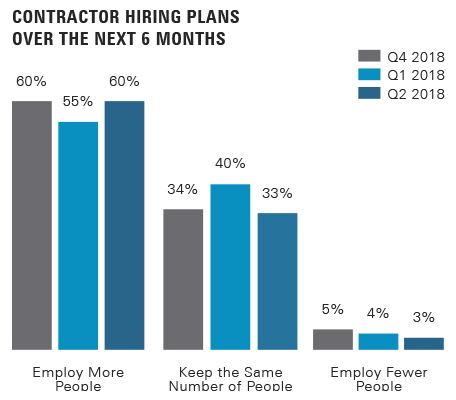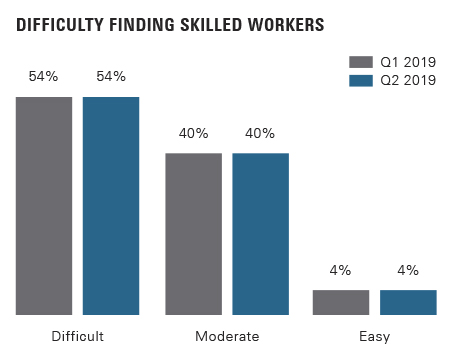Addressing a persistent challenge
According to the Q2 2019 Commercial Construction Index (CCI), when looking at the market trends regarding the workforce, more contractors expect to increase hiring in the next 6 months, while finding skilled workers is a persistent challenge.
CONTRACTORS EXPECT TO EMPLOY MORE WORKERS
Well over half (60 percent) of contractors expect to employ more people over the next 6 months, a return to Q4 2018 expectations after a drop in Q1 2019. Robust levels of backlog and high expectations that the market will provide more work contribute to this finding.
FINDING SKILLED WORKERS REMAINS A CHALLENGE
The challenge of finding skilled workers has remained consistent since the launch of the CCI in 2017. This quarter, the findings directly match those of Q1 2019, with 94 percent of contractors reporting moderate to high levels of difficulty finding skilled workers.
VARIANCE BY FIRM TYPE
A far greater percentage (63 percent) of specialty trade contractors report a high level of difficulty in finding skilled workers, compared with GCs, who are more evenly split between high (47 percent) and moderate (43 percent) levels of difficulty.
ABOUT THE INDEX
The USG Corporation + U.S. Chamber of Commerce Commercial Construction Index is a quarterly economic index designed to gauge the outlook for, and resulting confidence in, the commercial construction industry. USG Corporation and the U.S. Chamber produce this Index, along with Dodge Data & Analytics (DD&A). Each quarter, researchers from DD&A source responses from their Contractor Panel of more than 2,700 commercial construction decision-makers in order to better understand their levels of confidence in the industry and other key trends. This panel allows DD&A to provide findings that are representative of the entire U.S. construction industry by geography, size, and type of company. For more, visit www.commercialconstructionindex.com.
Note: Percentages for difficulty levels are based on ratings using a 10-point scale, where the three points at the bottom (1–3) indicate a high level of difficulty and the three points at the top (8–10) indicate a low level of difficulty.



